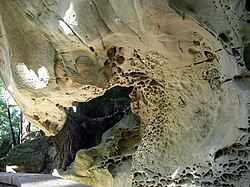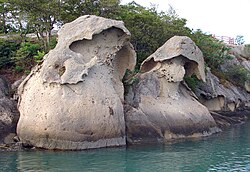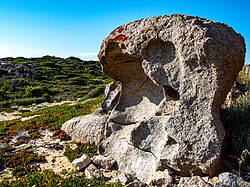
Tafoni (singular: tafone) are cavities that develop in granular rock.
Although various definitions[ example needed] can be found[ by whom?] in the scientific literature, tafoni are commonly defined as small (less than 1 cm (0.39 in)) to large (greater than 1 meter (3.3 ft)) cavity features that develop in either natural or manmade, vertical to steeply sloping, exposures of granular rock (i.e., granite, sandstone) with smooth concave walls, and often round rims and openings. Recognized subcategories of tafoni include honeycomb, stonelace, alveolar (less than 2 cm (0.79 in)), sidewall, basal, nested, and relic tafoni. It is also commonly synonymous with nido d’ape roccioso in Italian. [1]
The etymology of the word tafoni is unclear. Tafoni may come from the Greek word taphos, tomb, or it may stem from a Corsican or Sicilian word for holes, taffoni, or from tafonare meaning to perforate. The earliest known publication of the term tafoni was in 1882. [1] [2]
Distribution
Tafoni often occur in groups that can riddle a hillside, cliff, or other rock formation. They typically develop in siliceous, either coarse-grained ( sandstone) or coarsely crystalline ( granite), rock types. They also have been observed in lacustrine silts, tuffs, and conglomerates. They can be found in all climate types, but are most prolific in salt-rich environments, such as deserts and coastal zones. They have been found across the Earth, with dramatic forms found in the Jodhpur- Ajmer section of India's Thar Desert, Petra, Jordan, Coastal California, and Australia, and even in the Arctic regions and Antarctica. The common factors in the environments in which they are found are high salt concentrations and frequent or occasional desiccating conditions. [1] [3]
Origin
Many explanations have been proposed for the origin of tafoni. They include marine abrasion; wind corrosion; mechanical weathering resulting from short-term temperature variations; chemical weathering of the interior of the rock ( core-softening) under a protective crust ( case-hardening) followed by mechanical removal of the softened material; biogeochemical weathering by lichens; temperature variations acting on salt efflorescence in coastal regions; and salt weathering. Starting in the 1970s, most workers have advocated salt weathering as the primary explanation for the formation of tafoni. Currently, tafoni are considered to be polygenetic in origin being the result of complex interaction of physical and chemical weathering processes, which include salt weathering and cyclic wetting and drying. [1] [4]
-
Tafoni from Antarctica
-
Tafoni formation in the mountains near San Francisco.
-
Tafoni in sandstone, Südpfalz, Rheinland-Pfalz, Germany
-
Tafoni at Elgol, Isle of Skye
-
Tafoni formations, named Gatbawi (Hat Rock), found on the shore of Mokpo's east harbor, near the mouth of the Yeongsan River, South Jeolla Province, South Korea.
-
Tafoni on the shore of Corsica.
-
Tafoni in the mountains of Corsica.
-
Tafoni in conglomerate rock, Corsica.
See also
- Honeycomb weathering – Form of cavernous weathering and subcategory of tafoni, a similar weathering landform
References
- ^ a b c d Paradise, T.R., 2013. Tafoni and other rock basins. In: Shroder, J. (Editor in Chief), Pope, G.A., (Ed.), Treatise on Geomorphology. Academic Press, San Diego, CA, vol. 4, Weathering and Soils Geomorphology, pp.111–126.
- ^ Hans Henrik Reusch (1882) Notes sur la géologie de la Corse (Notes on the geology of Corsica), Bulletin de la Société géologique de France, 3rd series, 11 : 53-67 ; see p. 65. From p. 65: "Le peuple appelle ces cavités, quand elles sont petites, des tafoni ; quand elles sont grandes, des grotte." (People call these cavities, when they're small, tafoni ; when they're large, caves.)
- ^ Turkington, A.V. and Phillips, J.D., 2004. Cavernous weathering, dynamical instability and self‐organization. Earth Surface Processes and Landforms, 29(6), pp.665-675.
- ^ McBride, E.F. and Picard, M.D., 2000. Origin and development of tafoni in tunnel spring tuff, Crystal Peak, Utah, USA. Earth Surface Processes and Landforms, 25(8), pp.869-879.
External links
- www.tafoni.com Comprehensive explanation of tafoni, explanations of how they form, images, references
- Gallery of tafoni along California's Central Coast








